Diabetes Mother of All Maladies
Diabetes is emerging as one of the most common and challenging health problems of the 21st century. Rapidly increasing and reaching epidemic proportions, the disease causes substantial morbidity and mortality affecting even the youth. It has become a major public health issue, which may make India Diabetes World Capital by 2030…
By Amresh K Tiwary
D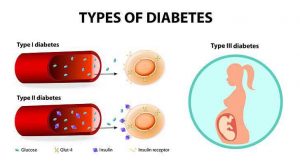 iabetes mellitus is a disease in which the body’s ability to produce or respond to insulin is impaired. Insulin is a hormone that is needed to convert sugar, starches and other food into glucose or energy needed for daily life. Diabetes results in abnormal metabolism of carbohydrates and elevated levels of glucose in the blood.
iabetes mellitus is a disease in which the body’s ability to produce or respond to insulin is impaired. Insulin is a hormone that is needed to convert sugar, starches and other food into glucose or energy needed for daily life. Diabetes results in abnormal metabolism of carbohydrates and elevated levels of glucose in the blood.
The cause of diabetes continues to be a mystery, although both genetics and environmental factors such as obesity and lack of exercise appear to play roles.
The increased thirst and urination, increased hunger, fatigue, blurred vision, numbness or tingling in the feet or hands, sores that do not heal and unexplained weight loss are common symptoms of diabetes.
Diabetes is a group of metabolic disorders characterized by hyperglycaemia resulting from defects in insulin secretion, insulin action or both. Chronic hyperglycaemia is associated with long term damage, dysfunction and failure of various organs especially the kidneys, eyes, nerves, heart and blood vessels. Several pathogenic processes are involved in the development of diabetes. These range from autoimmune destruction of the beta cells of the pancreas with consequent insulin deficiencies to abnormalities that result in resistance to insulin action.
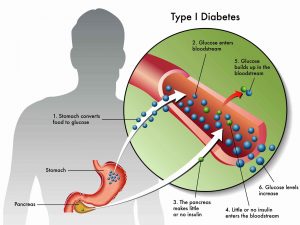 Types of Diabetes
Types of Diabetes
Symptoms of type-I diabetes can start quickly in a matter of weeks. Symptoms of type-II diabetes often develop slowly over the course of several years—and can be so mild that you might not even notice them. Many people with type-II diabetes have no symptoms. Some people do not find out they have the disease until they have diabetes-related health problems, such as blurred vision or heart trouble.
In ancient times, diabetes was described of three types – caphaj prameh pity or wath prameh. In modern times with the discovery of insulin in 1932 and the development of method for estimation of insulin in blood, two types of diabetes became well known like type-I where insulin is absent or present in very low quantity and Type-II where insulin is not deficient. It is not deficient but probably there is problem in secretion. In 1989 with the concept of insulin sensitivity, the understanding of type-II diabetes became clear. Type-II involves more than 90% diabetic population.
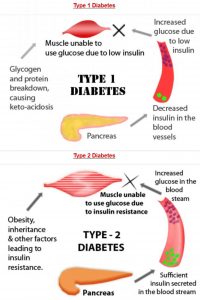 Type-I diabetes
Type-I diabetes
Type-I diabetes occurs when your immune system, the body’s system for fighting infection, attacks and destroys the insulin-producing beta cells of the pancreas. According to doctors, type-I diabetes is caused by genes and environmental factors, such as viruses, that might trigger the disease.
Type-I diabetes is a result of the progressive destruction of beta cells which lead to severe insulin deficiency. Although the symptoms have a relatively sudden onset, the underlying pathological changes occur over a prolonged period. Beta cells destruction appears to be an autoimmune process triggered by a variety of environmental factors along with genetic susceptibility which activates this autoimmune process.
Type-II diabetes: Type-II diabetes, the most common form of diabetes, is caused by several factors, including lifestyle and genes. You are more likely to develop type-II diabetes if you are not physically active and are overweight or obese. Extra weight sometimes causes insulin resistance and is common in people with type-II diabetes. The location of body fat also makes a difference. Extra belly fat is linked to insulin resistance, type-II diabetes, and heart and blood vessel disease.
Type-II diabetes usually begins with insulin resistance, a condition in which muscle, liver, and fat cells do not use insulin well. As a result, your body needs more insulin to help glucose enter cells. At first, the pancreas makes more insulin to keep up with the added demand. Over time, the pancreas can’t make enough insulin, and blood glucose levels rise.
The etiology of type II diabetes is not established. The principle underlying defects are reduced insulin sensitivity and impaired beta cell function. Together these defects initiate a sequence of events that ultimately leads to widespread metabolic imbalance and clinical diseases. Type-II diabetes begins insidiously and progresses slowly.
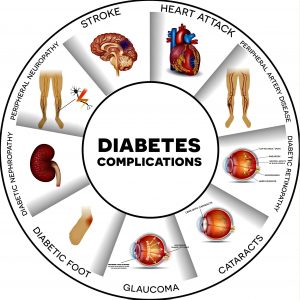 Changing parameters
Changing parameters
All these years, glucose level in blood was diagnostic marker in diabetes. The American Diabetic Association until 1997 used to recommend that fasting glucose up to 140 mg/dl and up to 180 mg/dl is the normal limit. This limit was lowered to 126 mg/dl to 126 mg/dl and world population of diabetics got increased by 14%. In 2003 again this limit was reduced to 100 and the world population of diabetic got further increased.
Apart from type-1 and type-II diabetes, there is 3rd type of diabetes called 1.5 (one point five) type diabetes described as latent auto immune disease called Latent Autoimmune Diabetes of Adulthood (LADA), which has a slower course of onset than type 1 diabetes diagnosed in juveniles.
Complication arising out of diabetes
Diabetes is called the king of all diseases because of various complications which include Micro Vascular (Nephropathy and Retinopathy) and Macro Vascular (Hypertension, Artericulose and Neuropathy) diabetes.
Retinopathy
Eye complications like retinopathy and cataract are the major causes of blindness. The most important fact is that, this blindness is preventable. This is one of the most common micro vascular complications of diabetes. The prevalence of retinopathy increases with the duration of diabetes. Loss of pericytes and the development of non-perfuse acellular capillaries are the earliest structural abnormalities. Obliteration of retinal blood vessels is probably the inciting process in diabetic retinopathy and this result in ischemia and liberation of growth factor in response to which there is proliferation of endothelial cells and fibrous tissue in adjacent capillaries and there is a tendency of increased vascular permeability in these vessels. This results in leakage leading to haemorrhages.
Neuropathy
Diabetes neuropathies are a group of heterogeneous syndrome with considerable morbidity. At least 50% of the diabetic patients develop neuropathy within 25 years of diagnosis. Diabetic neuropathy is a description term meaning a demonstrable disorder, either clinically evident or subclinical that occurs without other causes for peripheral neuropathy. The neuropathic disorder includes manifestation in the somatic and autonomic parts of the peripheral nervous system.
Nerve function deteriorates in response to pressure, ischemia and metabolic abnormalities like chronic hyperglycaemia and sorbitol accumulation with myoinositol depletion. There is patchy loss of myelin and nerve fibres with capillary basement membrane thickening, axonal degeneration and demyelization with involvement of both small and large nerve fibres. The varied clinical presentation and manifestation of neuropathy among diabetic patients reflect the heterogeneity of this problem.
Nephropathy
Diabetic nephropathy is a micro vascular complication of diabetes. Diabetes has become one of the most common causes of end stage renal disease (ESRD). About 30% of patients with type 1 and type-II diabetes develop evidence of nephropathy, but in type-II diabetes a considerably smaller fraction of these progress to ESRD. Evolution of diabetic nephropathy is through varies stages before leading to chronic renal failure.
Over 40% of new cases of end-stage renal disease (ESRD) are attributed to diabetes.
Other complications
Diabetes causes extensive metabolic disorder affecting carbohydrate, protein as well as fat because of distribution of fat metabolism. There is coronary heart disease leading to heart attack and even obesity is also because of fat disorders. Children are prone to Type-I diabetes. Because of high glucose level, proteins are more prone to infection. Glucose is best medium for bacterial growth in this case. Such increased level of infection leads to Diabetic Foot Ulcer. In this case, amputation is to be done for patients as treatment.
Although high glucose is the sign of diabetes but patients dying only because of diabetes are less as compared to the death because of low blood sugar.
Treatment of diabetes
Until 1990, sulfonylureas (glyburide glipizide etc) and biguanides (metformin) drugs were available in addition to insulin. Sulfonylureas at one time was expected to cause heart problems and during that period, metformin became more popular. However, the study was shown to be defective and sales of sulfonylureas went down but in 1987 when it was reported that sulfonylureas work through ATP dependent K plus channels, the fact could not be negative and there was search for newer drug. Human Peroxisome Proliferator-Activated Receptor (PPAR) comprising glitazones and pioglitazone, an antidiabetic agent that improves hyperglycaemia and hyperlipidaemia in obese and diabetic animals via a reduction in hepatic and peripheral insulin resistance were the next group of drugs that became more popular. Of course, these three types are inter-related.
 Recently in last decades gliptines (DPP4 inhibitions) are on the fore front. It is still a mystery whether these drugs replace Metformin or Sulfonylureas. Metformin is a widely prescribed drug for treating type-II diabetes. According to Dr. N P Singh, Senior Consultant, Internal Medicine and Nephrology, Max Super speciality Hospital, Vaishali, “Metformin is often the first medication that will be prescribed to people with type-II diabetes. Metformin helps to lower blood glucose levels by reducing the amount of glucose produced and released by the liver, and by increasing insulin sensitivity”. In fact sulfonylureas and its relation with cardiovascular disease in addition to a great Framingham study of 1980 opened a new era in diabetes, that is, cardiovascular metabolic diabetes.
Recently in last decades gliptines (DPP4 inhibitions) are on the fore front. It is still a mystery whether these drugs replace Metformin or Sulfonylureas. Metformin is a widely prescribed drug for treating type-II diabetes. According to Dr. N P Singh, Senior Consultant, Internal Medicine and Nephrology, Max Super speciality Hospital, Vaishali, “Metformin is often the first medication that will be prescribed to people with type-II diabetes. Metformin helps to lower blood glucose levels by reducing the amount of glucose produced and released by the liver, and by increasing insulin sensitivity”. In fact sulfonylureas and its relation with cardiovascular disease in addition to a great Framingham study of 1980 opened a new era in diabetes, that is, cardiovascular metabolic diabetes.
Due to diabetes, there is wasting of muscles and patients feel weakness. Insulin has been the major focus in treatment of type-I diabetes. However, it is very common that in type-II diabetes whereas 70 to 80 percent diabetic population has a normal to high insulin level but insulin injections are given to these patients and it is still a major mystery.
Humulin (Recombinant DNA insulin), a man-made insulin used to control high blood sugar in adults, is known to reduce high blood sugar (glucose) levels in patients with diabetes mellitus. Human insulin was expected to do miracles in the treatment of diabetes. Experiment study in animals proved that insulin can prevent every cardiovascular change but it is still a mystery as to why diabetics continue to suffer from cardiovascular disease.
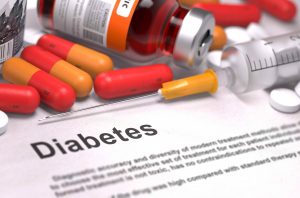
Diabetes prevalence in India
Diabetes is rapidly emerging as a one of the major health problem in India, especially in urban areas. In urban areas the prevalence of type-II diabetes has been steadily increasing from 2.1 % reported in early 1970 to 12.1 % in 2000. There are an equally large number of persons with Impaired Glucose Tolerance (IGT), many of them will develop type II diabetes in future. Even in rural areas there are evidences for increasing prevalence of type-II diabetes. The rapid urbanization, rapid increase in population, high ethnic susceptibility to diabetes and changes from traditional lifestyles are the reasons for diabetic epidemic. The WHO has recently estimated that the persons with diabetes in India are likely to increase to 87 million by 2030. Diabetes is therefore rapidly emerging as a major public health challenge.
All over the globe the prevalence of diabetes is rising at an alarming rate. Over the past 30 years, the consideration in the status of diabetes has changed from a mild disorder of the elderly persons to one of the major causes of morbidity and mortality affecting the youth and middle aged people. It is importantly noted that the rise in prevalence is seen in all six inhabited continents of the globe.
The global burden of type-II diabetes mellitus may increase to 438 million people in 2030 which is a 65% increase. The impact of type II diabetes mellitus are significant as a life threatening disease; it increases morbidity and mortality and affects the quality of life. Since, the disease and its complications cause heavy economic problems for diabetic patients; it will affect their families and society. The knowledge about the predisposition of Indians to get type-II diabetes mellitus is necessary for future planning of health care policy and delivery in order to ensure that the burden of this disease is reduced.

